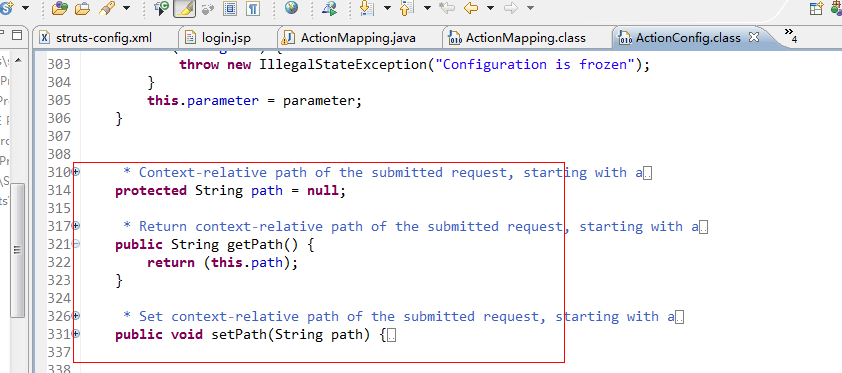深入浅出学习Struts1框架(十)-ActionMapping的生成和查找
来源:互联网 发布:淘宝怎么设置优惠活动 编辑:程序博客网 时间:2024/06/04 18:03
前几篇博客主要介绍的ActionServlet的初始化和Struts1是如何完成截取字符串工作的,今天继续分析Struts1截取完字符串所要做的工作。
在struts专栏的开篇mvc小实例中我们编写了ActionMapping这样一个类、struts-config.xml配置文件,在那时我们对截取的字符串匹配,利用dom4j来读取了配置文件的信息,并且把他以ActionMapping的形式保存在内存中。
今天我们深入的来看看struts1是怎样拿到ActionMapping的,依旧和上篇的博客思路一样,利用断点调试的方式来进入源代码中,具体做法见上篇博客。
紧接着上篇博客,我们的断点走出了processpath方法,

在上一篇博客中我们已经讲解了,这个方法是用来截取字符串的,今天我们来看怎样获得ActionMapping的方法---processMapping。
在此之前简单说一下ActionMapping,它的源代码中可以看出,其中最重要的属性和我们的mvc小实例中的ActionMapping类似,都是有path、type还有forwardMap,主要是对应的struts-config配置文件而来,这个就是保存这个配置文件的信息到内存中。
具体的mvc小实例的ActionMapping代码如下:
package com.cjq.servlet;import java.util.Map;public class ActionMapping {private String path;private Object type;private Map forwardMap;public String getPath() {return path;}public void setPath(String path) {this.path = path;}public Object getType() {return type;}public void setType(Object type) {this.type = type;}public Map getForwardMap() {return forwardMap;}public void setForwardMap(Map forwardMap) {this.forwardMap = forwardMap;}}而Struts中的Actionconfig(因为ActionMapping是继承这个ActionConfig的,所以我们来看ActionConfig更加直接)的代码如下:



从这两部分代码来看,更加印证了我在开篇写的mvc小实例是一个struts框架的雏形。
讲完ActionMapping的一些内容后,相信对ActionMapping有所了解,那么系统是如何生成ActionMapping和如何找到ActionMapping的呢?这就是今天要说的整体:
不知道读者还记不记得,我们在分析实例的第一篇的时候web.xml中有一个<load-on-startup>2</load-on-startup> 配置信息,这个信息就是说明了但服务器已启动就动态读取struts-config配置文件把配置文件的信息put到ActionMapping中。所以当我们运行服务器的时候,我们在内存中已经存在对应struts-config配置文件信息对应的ActionMapping。今天就是要通过processMapping读取这个ActionMapping类。
进入断点调试,首先在processMapping方法上设置断点。

进入源代码中:
/** * <p>Select the mapping used to process theselection path for this request. * If no mapping can be identified, createan error response and return * <code>null</code>.</p> * * @param request The servlet request weare processing * @param response The servlet response weare creating * @param path The portion of the requestURI for selecting a mapping * * @exception IOException if an input/outputerror occurs */ protectedActionMapping processMapping(HttpServletRequestrequest, HttpServletResponse response, String path) throws IOException { // Is there a mapping for this path? ActionMapping mapping = (ActionMapping) moduleConfig.findActionConfig(path); // If a mapping is found, put it in the request and return it if (mapping != null) { request.setAttribute(Globals.MAPPING_KEY, mapping); return (mapping); } // Locate the mapping for unknown paths (if any) ActionConfig configs[] = moduleConfig.findActionConfigs(); for (int i = 0; i < configs.length; i++) { if (configs[i].getUnknown()) { mapping = (ActionMapping)configs[i]; request.setAttribute(Globals.MAPPING_KEY, mapping); return (mapping); } } // No mapping can be found to process this request String msg = getInternal().getMessage("processInvalid"); log.error(msg + " " + path); response.sendError(HttpServletResponse.SC_NOT_FOUND, msg); return null; }首先我们传入我们在上一步截取的路径,通过moduleConfig的findAction方法来查找ActionConfig,并且返回ActionMapping。具体代码是:
ActionMapping mapping =(ActionMapping) moduleConfig.findActionConfig(path);
如果找到,那么就讲ActionMapping存放到request的context中。代码:
if (mapping != null) { request.setAttribute(Globals.MAPPING_KEY, mapping); return (mapping); }如果没有通过path找到mapping,则在Actionconfig中遍历为未知路径寻找mapping,如果找到则存放到request中,如果没有找到,则返回错误信息,具体代码如下:
// Locate the mapping for unknownpaths (if any) ActionConfig configs[] = moduleConfig.findActionConfigs(); for (int i = 0; i < configs.length; i++) { if (configs[i].getUnknown()) { mapping = (ActionMapping)configs[i]; request.setAttribute(Globals.MAPPING_KEY, mapping); return (mapping); } } // No mapping can be found to process this request String msg = getInternal().getMessage("processInvalid"); log.error(msg + " " + path); response.sendError(HttpServletResponse.SC_NOT_FOUND, msg); return null;通过这一段代码我们就能通过截取的字符串来找到匹配的ActionMapping,并且为下面获取ActionForm做铺
垫。这篇博客主要是让读者明白,Struts1是如何生成ActionMapping和如何获得ActionMapping的,下一篇博客要介绍如何获得ActionForm。敬请期待!
- 深入浅出学习Struts1框架(十)-ActionMapping的生成和查找
- 深入浅出学习Struts1框架(十)-ActionMapping的生成和查找
- 深入浅出学习Struts1框架(十一)-利用ActionMapping来创建ActionForm
- 深入浅出学习Struts1框架(十一)-利用ActionMapping来创建ActionForm
- 深入浅出学习Struts1框架(六):ActionServlet的实例化
- 深入浅出学习Struts1框架(六):ActionServlet的实例化
- Struts1框架学习(四)--struts1的本地化和国际化
- struts1学习之--7、ActionMapping的研究与分析
- 深入浅出学习Struts1框架(三):彻底去掉TestServlet中的字符串和if-else语句块
- 深入浅出学习Struts1框架(三):彻底去掉TestServlet中的字符串和if-else语句块
- 深入浅出学习Struts1框架(三):彻底去掉TestServlet中的字符串和if-else语句块
- 深入浅出学习struts1框架(五)--正式进入struts1框架学习,从一个实例开始
- 深入浅出学习struts1框架(五)--正式进入struts1框架学习,从一个实例开始
- 深入浅出学习struts1框架(五)--正式进入struts1框架学习,从一个实例开始
- 深入浅出学习Struts1框架(九):截取URL
- 深入浅出学习Struts1框架(九):截取URL
- 深入浅出学习struts1框架(四):从MVC模式代码认识struts1框架
- 深入浅出学习struts1框架(四):从MVC模式代码认识struts1框架
- ossec开源入侵检测系统安装配置
- jq上传的值出现部分乱码
- Android 下载SDK 和 升级SDK方法 查看android源码
- 编写支持错误处理的组件程序
- redhat Linux5 安装vsftp .
- 深入浅出学习Struts1框架(十)-ActionMapping的生成和查找
- Hbase+GlusterFS可行性
- ASM disk group mount fails with ORA-15036: disk is truncated [ID 1077175.1]
- 海量图片存储策略
- 概要设计与详细设计的区别
- java List 排序 Collections.sort() 对 List 排序
- 深入浅出硬盘分区表
- DTMF信号收、发芯片在微机通信中的应用(DTMF信号发生器芯片MT5087和接收器芯片MT8870)
- IPHONE多语言


